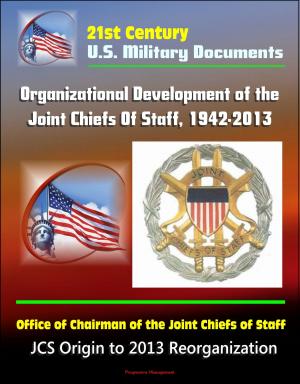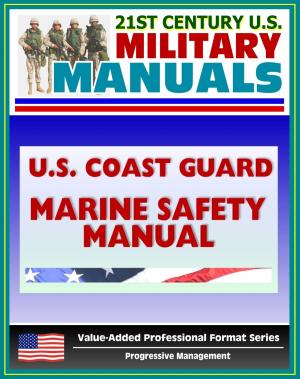21st Century U.S. Military Manuals: Generating Force Support for Operations (FM 1-01) - The Army's Generating Force, Enabling Strategic Reach (Professional Format Series)
Nonfiction, History, Military, United States| Author: | Progressive Management | ISBN: | 9781301887781 |
| Publisher: | Progressive Management | Publication: | October 10, 2012 |
| Imprint: | Smashwords Edition | Language: | English |
| Author: | Progressive Management |
| ISBN: | 9781301887781 |
| Publisher: | Progressive Management |
| Publication: | October 10, 2012 |
| Imprint: | Smashwords Edition |
| Language: | English |
Professionally converted for accurate flowing-text e-book format reproduction, this Army Field Manual defines the Army's generating force and establishes as doctrine the employment of its capabilities in support of ongoing joint and multinational operations and deployed forces. It describes how operating forces can access and employ generating force capabilities in support of ongoing operations. It incorporates lessons learned from recent and ongoing operations, including Operations Enduring Freedom and Iraqi Freedom, the War on Terrorism, the response to Hurricane Katrina, and others. This information allows operational Army forces to understand generating force capabilities and employ these capabilities successfully in support of ongoing operations. It enables generating force organizations to ready these capabilities. This manual describes how the joint force can access and employ generating force capabilities in support of operations. The generating force consists of Army organizations whose primary mission is to generate and sustain the operational Army.
Generating Force Support for Operations * Contents * PREFACE * INTRODUCTION * Chapter 1 * THE ARMY'S GENERATING FORCE * The Army * Effective Capabilities * Chapter 2 * THE OPERATIONAL ENVIRONMENT * Significant Societal Trends * Operational Variables * Threats * Full Spectrum Operations: The Army's Operational Concept * Unified Action * Joint Interdependence * ARFORGEN * Chapter 3 * EMPLOYING THE GENERATING FORCE * Categories of Support * Organization of Generating Force Capabilities * Supporting the Joint Campaign * Planning Support for Operations * Providing Capabilities * Accessing Capabilities * Chapter 4 * ADAPTING TO THE OPERATIONAL ENVIRONMENT * Understanding the Operational Environment * Support to Rapid Adaptation * Generating Capabilities for Operations * Chapter 5 * ENABLING STRATEGIC REACH * Support to Force Projection * Sustaining Deployed Forces * Building and Sustaining Operational Networks * Chapter 6 * DEVELOPING MULTINATIONAL PARTNER CAPABILITY AND CAPACITY * Stability Operations * Support for Security Force Assistance * Support for Infrastructure Development * Appendix * ORGANIZATIONS AND THEIR CAPABILITIES FOR OPERATIONAL SUPPORT * GLOSSARY * REFERENCES.
As a bonus, this reproduction includes the complete 2012 Army Leadership manual (FM 6-22), which describes the Army's view of leadership, outlines the levels of leadership (direct, organizational, and strategic), and describes the attributes and core leader competencies across all levels. The principal audience for ADRP 6-22 is all leaders, military and civilian. Trainers and educators throughout the Army will also use this publication. Commanders, staffs, and subordinates ensure their decisions and actions comply with applicable United States, international, and, in some cases, host-nation laws and regulations. Commanders at all levels ensure their Soldiers operate in accordance with the law of war and the rules of engagement. It establishes and describes the leader attributes and core leader competencies that facilitate focused feedback, education, training, and development across all leadership levels. An ideal Army leader has strong intellect, physical presence, professional competence, moral character and serves as a role model. An Army leader is able and willing to act decisively, within the intent and purpose of superior leaders and in the best interest of the organization. Army leaders recognize that organizations, built on mutual trust and confidence, successfully accomplish missions.
Professionally converted for accurate flowing-text e-book format reproduction, this Army Field Manual defines the Army's generating force and establishes as doctrine the employment of its capabilities in support of ongoing joint and multinational operations and deployed forces. It describes how operating forces can access and employ generating force capabilities in support of ongoing operations. It incorporates lessons learned from recent and ongoing operations, including Operations Enduring Freedom and Iraqi Freedom, the War on Terrorism, the response to Hurricane Katrina, and others. This information allows operational Army forces to understand generating force capabilities and employ these capabilities successfully in support of ongoing operations. It enables generating force organizations to ready these capabilities. This manual describes how the joint force can access and employ generating force capabilities in support of operations. The generating force consists of Army organizations whose primary mission is to generate and sustain the operational Army.
Generating Force Support for Operations * Contents * PREFACE * INTRODUCTION * Chapter 1 * THE ARMY'S GENERATING FORCE * The Army * Effective Capabilities * Chapter 2 * THE OPERATIONAL ENVIRONMENT * Significant Societal Trends * Operational Variables * Threats * Full Spectrum Operations: The Army's Operational Concept * Unified Action * Joint Interdependence * ARFORGEN * Chapter 3 * EMPLOYING THE GENERATING FORCE * Categories of Support * Organization of Generating Force Capabilities * Supporting the Joint Campaign * Planning Support for Operations * Providing Capabilities * Accessing Capabilities * Chapter 4 * ADAPTING TO THE OPERATIONAL ENVIRONMENT * Understanding the Operational Environment * Support to Rapid Adaptation * Generating Capabilities for Operations * Chapter 5 * ENABLING STRATEGIC REACH * Support to Force Projection * Sustaining Deployed Forces * Building and Sustaining Operational Networks * Chapter 6 * DEVELOPING MULTINATIONAL PARTNER CAPABILITY AND CAPACITY * Stability Operations * Support for Security Force Assistance * Support for Infrastructure Development * Appendix * ORGANIZATIONS AND THEIR CAPABILITIES FOR OPERATIONAL SUPPORT * GLOSSARY * REFERENCES.
As a bonus, this reproduction includes the complete 2012 Army Leadership manual (FM 6-22), which describes the Army's view of leadership, outlines the levels of leadership (direct, organizational, and strategic), and describes the attributes and core leader competencies across all levels. The principal audience for ADRP 6-22 is all leaders, military and civilian. Trainers and educators throughout the Army will also use this publication. Commanders, staffs, and subordinates ensure their decisions and actions comply with applicable United States, international, and, in some cases, host-nation laws and regulations. Commanders at all levels ensure their Soldiers operate in accordance with the law of war and the rules of engagement. It establishes and describes the leader attributes and core leader competencies that facilitate focused feedback, education, training, and development across all leadership levels. An ideal Army leader has strong intellect, physical presence, professional competence, moral character and serves as a role model. An Army leader is able and willing to act decisively, within the intent and purpose of superior leaders and in the best interest of the organization. Army leaders recognize that organizations, built on mutual trust and confidence, successfully accomplish missions.















